Three of my favorite things!
I’m going to start Japanese, at Kotten Sushi, Borges 1891, Palermo, on a very hot (35C/95F) afternoon, with little more than a wall mounted fan offering cooling in the outdoor space, and as far as I could tell, even less indoors. The menu offers up Nikkei and vegan Japanese dishes, mostly sushi. [I also didn’t realize, until I went to add this spot to our sushi map, that I’d reviewed a delivery order from them about ten months ago, with almost the same thoughts.] [Closed]
I don’t know if it was because we were the first, and for awhile, only, customers, but we each got a welcome greeting of a half glass of lemonade (quite refreshing, with ginger), and a vegan sushi roll piece with carrot, confited tomato, and red cabbage inside the rice, and a slice of avocado atop. Pretty good, actually. But a table that came in twenty minutes later, didn’t get either.
Salmon gyoza were decent. Nice flavors, well stuffed with salmon. A little dry, despite the glaze on them, mostly because the wrappers were really thick and just bordering on not quite cooked through. 600 pesos.
And a selection of sushi – the nigiri of salmon with citrus is noted on the menu as having lemon zest, and being bathed in a passionfruit sauce. It’s not bathed, the sauce is served separately, along with what was stated as a mustard sauce – it wasn’t, it was a mild aji amarillo sauce, and what they call barbecue sauce, but tasted more like a sort of mild sesame vinaigrette. The “dual fish” roll has a “spicy salmon tartare” and avocado inside, and topped with a seared salmon tataki – nothing spicy about it, but tasty nonetheless. And the “limeño” roll was stuffed with a cold fried, and somewhat chewy, prawn, a thin layer of sole, and avocado. This one had the “picante” in the form of shichimi powder, liberally sprinkled over it, but it was hard to get over that prawn, and again, the bathed in sauce was separate, the aji amarillo sauce. Respectively, 800, 1300, and 1300 pesos.
It was all fine, just nothing that wowed us. They do have quite good, and unsweetened, iced tea, which is a huge plus in my book, anywhere, anytime. Some service missteps – the lack of knowledge of what was being served, to start with. The other was that the power went out around the end of our meal, literally while they were about to process our credit card. Their response was to demand cash, or an immediate bank transfer, neither of which was feasible in the moment. It was only after a bit of discussion (mostly between waitress and manager, thankfully not involving us) that they agreed to simply copy the card information and process it manually later, which they did that evening.
And, off to one of our two Koreatowns, for the first time since pre-pandemic – actually since December 2019! We decided on the Floresta Koreatown, and met up at one of the two branches of Han Obaegnyeon, at Campana 685 (the other is in the Bajo Flores Koreatown at Pumacahua 1629). In the same two-family house as Dagi & Myeoni, the Korean fried chicken place I tried years ago.
Now, while normally, they have a menu featuring 23 dishes (though some are just combinations of others), they’ve been closed at this branch since the pandemic started and just reopened at the beginning of January. As of when we visited, they only had a few of the dishes available. However, they expect to be back to full on operation shortly, so I’ll give you the full menu translation (as best I can – I may be slightly off on a couple of the dishes, but I think I got them all):
1. Sundubu (dwaeji/heunghab/saeu) – soft tofu stew (pork/mussels/shrimp)
2. Bulgogi deopbab – beef rice bowl
3. Gogi bokk-eumbab/dubu bokk-eumbab – meat fried rice/tofu fried rice
4. Doenjang jjigae/jeong-gugjang – soybean paste soup/extra strong
5. Yeolmu naengmyeon – cold buckwheat noodles in broth with spicy daikon
6. Sopa para chicos – literally, soup for kids, and beyond that, I have no idea
7. Sundae guk – blood sausage soup (handwritten is extra blood sausage)
8. Sul guk – “hangover” soup – spicy beef broth, beef, cabbage, vegetables
ttugbaegi – “stone bowl”, individual portion
jeongol – “hotpot”, shareable portion for the table
9. Seolleong tang – ox bone soup
10. Naejang tang – intestine soup
11. Yeomso tang (ttugbaegi) – lamb soup (stone bowl)
12. Sundae 1 inbun – blood sausage 1 serving
13. Sundae 1kg – blood sausage 1 kilogram
14. Meoligogi – “head meat”, sliced pork cheek
15. Sundae + meoligogi – blood sausage and pork cheek
16. Wangjogbal jeongsig – pig’s trotter platter
17. Tteokbokki – spicy rice cakes
18. Sundae + tteokbokki – blood sausage and spicy rice cakes
19. Sundae + gobchangbokk-eum – blood sausage and stir-fried pork tripe
20. Jeyugbokk-eum – stir-fried pork
21. Gamja tang – pork bone soup
22. Gobchang jeongol – pork tripe hotpot
23. Yeomso jeongol – lamb hotpot
A small, but tasty array of banchan – mostly usual suspects, except in the upper left corner, a sort of spicy sweet braised beef dish that we hadn’t encountered before.
My companion got the lamb soup (#11), which has been a favorite of ours at Casa Bonga. This version, while good, didn’t have the kick of the Bonga soup. We’d still happily eat it again. 2000 pesos (also available in shareable hotpot versions at 4000 and 6000 pesos).
I got one of my favorites, the fermented soybean paste soup (#4). Again, good, but missing the oomph I usually like of that funky paste. I didn’t know until later, translating the menu in more detail, that there was an option to have it “extra strong”, no extra charge. Next time! 1200 pesos.
Not one of the best places we’ve had Korean food, but quite good. Really nice people – friendly and helpful. And given that Dae Jang Geum, a few steps away at the corner, closed up permanently during the pandemic, it may be one of the better choices in the immediate area for soups, though Singul Bongul is only a couple of minute’s walk away. I’d go back and try more dishes though, especially once they’re up to full speed.
After lunch, a little relaxation and an afternoon caffeine hit, just down the block at Jinni’s Coffee, Morón 3322.
Cute baristas, a couple of them, and when they were out of one of our two choices for an iced coffee and I feigned shock, one of them ran around the counter and clutched my arm assuring me he’d make things right, with a big smile. If I weren’t already married….
But good iced coffees, with different flavorings. My lunch companion got a caramel one, and I decided to try the “traditional Korean” misugaru, a powdered multigrain that the Koreans apparently imbibe as sort of a nutrition and protein drink. I liked it a lot, the first time I’ve encountered it, surprisingly. It’s a mix of “barley, oats, quinoa, sweet rice, brown rice, lentils, soybean, millet, adzuki beans”. And sometimes other grains as well. It gives it an interesting flavor that reminded me of toasted pumpkin seeds. Most of the iced coffees run around 350 pesos.
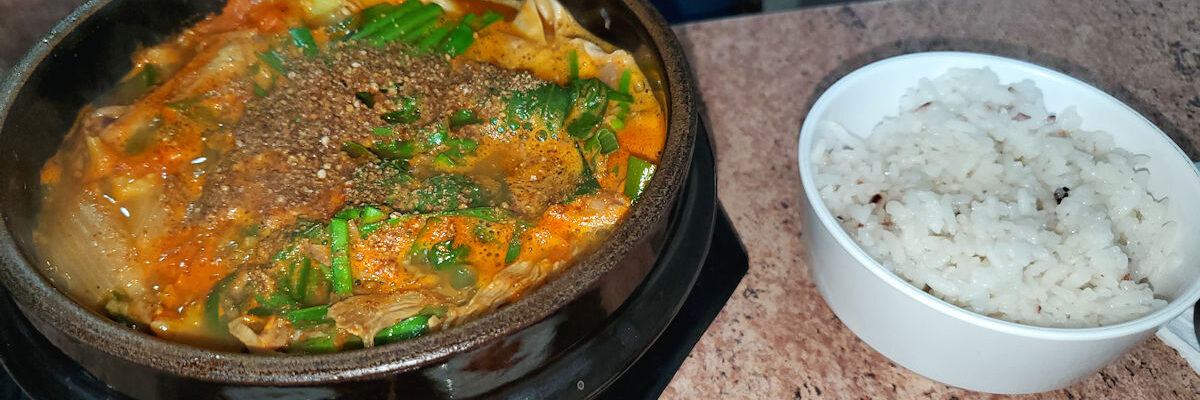
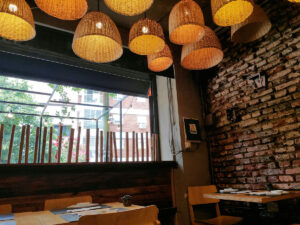
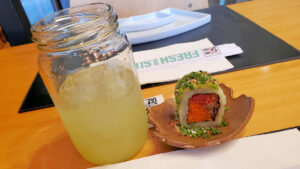
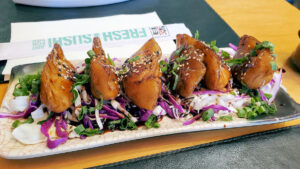
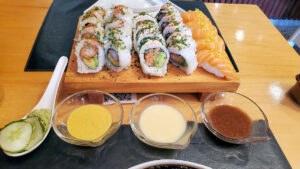
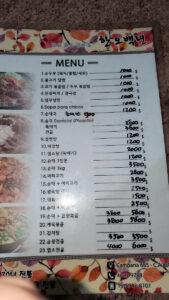
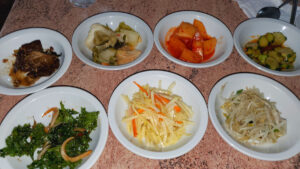
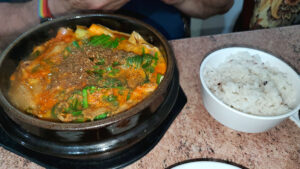
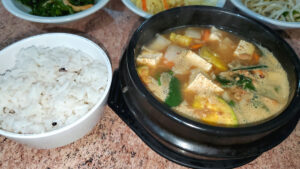
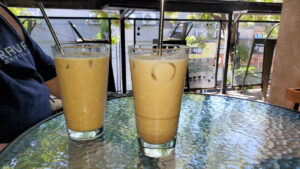
[…] Obaegnyeon, Pumacahua 1629, Flores. Back in January, two of us met up at the small house where the second branch of Han Obaeknyeon is located. We had a […]